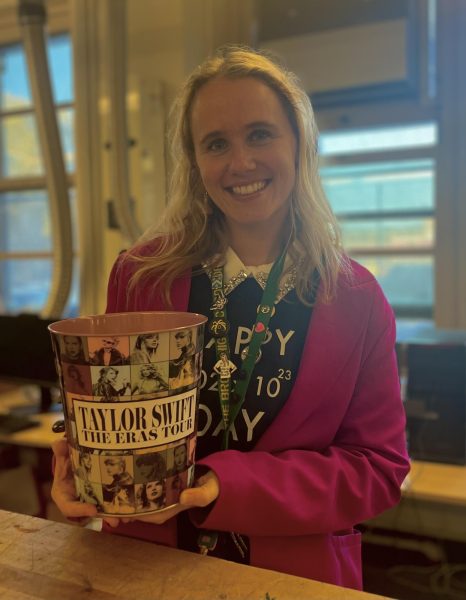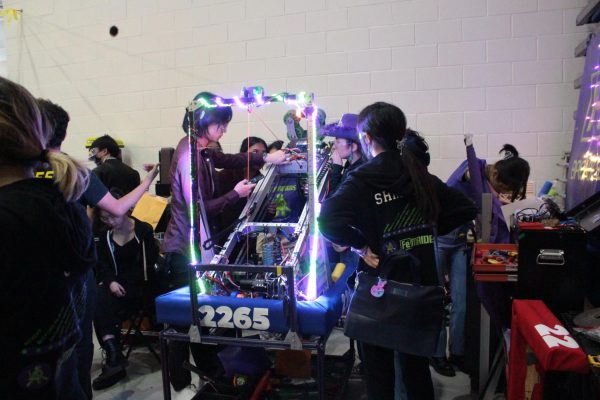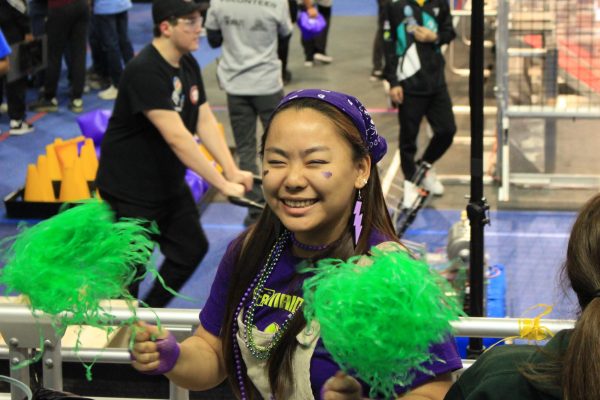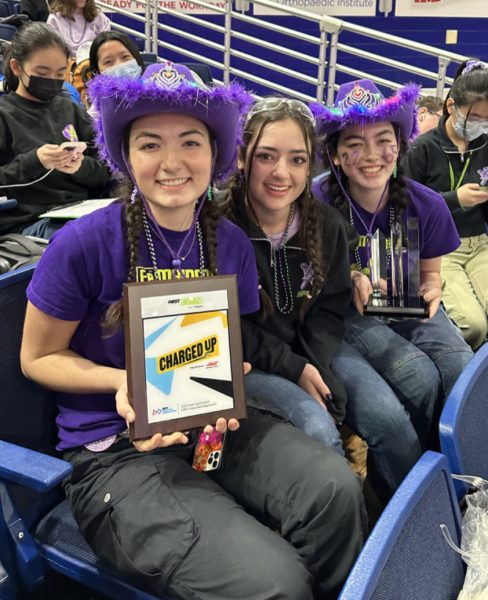With their bright purple and green flannel pants, keychains, hoodies, and zip-ups, the FeMaidens, Bronx Science’s all-girls Robotics team, have become a staple of Bronx Science culture. Their story began in 2006, when female members of the co-ed robotics team, the Sciborgs, made the ambitious decision to create one of New York’s first all-girls teams. They sought to tackle the discouraging gender inequalities within the STEM field. Their vision continues to be the essence and purpose of the FeMaidens today, who strive to create equal opportunities for not only girls, but all gender minorities.
Both the Maidens and Sciborgs are FIRST (For Inspiration and Recognition of Technology) Robotics teams. FIRST is a nonprofit organization that strives to provide students with opportunities in the fields of STEM. Now approaching its 35th anniversary, FIRST has amassed a robotics community of nearly three million students and alumni from 4,000 teams globally.
An academic school year on a FIRST robotics team is divided into three parts: preseason, build/competition season, and postseason.
The offseason periods (pre- and post-season) are focused on preparation and reflection, as well as team and inter team building. The build season that follows is a six-week period in which FIRST robotics teams each create an industrial-sized robot – of around 120 pounds – with limited time and resources.
The Maidens celebrate the beginning of a new build season every January with the ‘kick-off.’ Kick-off is a live broadcast that announces the new competition objectives and regulations. Last year, FIRST robotics teams from over 30 countries tuned into the broadcast, eagerly awaiting the announcement. The Bronx Science auditorium buzzed with excitement from the FeMaidens – who were all bright-eyed despite their tiresome morning commute to school.
As soon as kick-off is over, FeMaidens begin working endless hours to assemble the hundred pound robot. They follow a new schedule of five meetings per week– Monday, Tuesday, Wednesday, Friday and Saturday. On the weekdays, FEMaidens stay at school until 6 p.m., and on Saturdays, they stay from 9 a.m. to 6 p.m. “I feel like I spend more time in Rooms 004 and 011 than in my own bedroom,” Felicia Yiu ‘26 said, with a laugh.
Then, during the months of March and April, they attend competitions on local and regional levels, competing for a spot in the FIRST championships. At the end of the build/competition season, the FIRST championship is held over the course of four days in Houston, Texas. Usually, teams from over 30 nations are in attendance.
To many, building these robots seems one-dimensional – build the robot and then duel other robots to secure a place in the championships. However, in reality, there are many more factors to a functioning robot and robotics team.
Teams are responsible for establishing their own “brands” based on their mission and goals. Many teams create their brands in accordance with the impact that they want to make on their community. FIRST places an emphasis on ‘impact’ and ‘cooperation,’ so teams are encouraged to foster positive change within the STEM community and their general communities.
Teams must also secure funding for the construction of their robots by finding sponsors that align with their mission statement.
Essentially, robotics teams have both business and engineering aspects to it.
The engineering of the robot alone is made up of many facets. The robot needs to be designed, constructed, and coded. Furthermore, there needs to be the bridging of construction and coding, with wires and batteries.
In order to increase their efficiency, the FeMaidens divide this multitude of responsibilities amongst four different departments: Engineering, Programming, Electronics and Marketing.
An Average Build Season Meeting
At the start of each meeting, FeMaidens of all departments gather in Room 004, exchanging conversations and laughing together. Sometimes, during build season, when the winter cold casts a blanket of drowsiness over the team, members will bring in baked goods and sweet treats to cheer each other up.

This year’s captain, Melody Jiang ’24, said, “When I first joined the team three years ago, the FeMaidens felt much more departmentalized; there weren’t many interactions between members of different departments. Last year, it was extremely heartwarming to see so many inter-departmental friendships form — it was equally as exciting to form these connections myself.”
After some inter-departmental socializing, the captain usually makes a few necessary housekeeping announcements or gives a few words of encouragement. The FeMaidens then disperse into their departmental rooms.
The engineering department occupies Room 004 and the ‘shop.’ ‘Shop’ is short for ‘workshop,’ and it is where all construction takes place. Safety goggles hang by the entrance, bedazzled with purple and green jewels or stickers – a show of FeMaidens’ spirit.
Inside the shop, a variety of machinery and materials lay in a sort of organized chaos. Some FeMaidens woodwork, sanding down wood and utilizing a CNC machine to laser cut necessary shapes. Others work with metal, shaping aluminum and iron or hammering nuts and bolts. Throughout the course of build season, the whirs and clangs of hard work in the shop can be heard from down the hall. “I love that the shop provides a safe, but hands-on building experience. I think it is a great privilege to have a space where we can be innovative while designing and building mechanisms. It is so exciting to be able to access and use different machinery; my favorites are the lathe and belt sander,” said Nina Shadrin ’26.
Some members of the engineering department camp out in the ‘purgatory,’ which serves as the team’s storage room. In the center of the room, a singular light bulb hangs from the ceiling, revealing stacks of boxes filled with robot-building materials. Multiple containers of awards, merchandise, and banners dating back to 2006 line the shelves of two metal lockers in the corner. “Unfortunately, I can’t tell you exactly when or why it was named Purgatory, but it’s a fitting name for the room. At first glance, it’s kind of a dreary environment, but the longer you work in it, the more used to it you get, and I’ve personally come to love working in purgatory,” said Ava Tsao ’25.
The dimly lit room only allows enough space for only one or two people to weave around. Usually, two members of the engineering department are selected to design and manage a system in which all of the materials in the purgatory are organized and accounted for. Tsao is one of these members. “I make a list of the items and what quantities of them we have, and as people take items out of purgatory, I adjust our supply lists accordingly. I also inform the heads of our department if there’s anything we may need. There’s always something to be counted, another to be put back, boxes of things to be rearranged, but honestly it’s all a part of the fun,” Tsao said.
Across the hall, programming and electronics work to implement codes and solder wires.
Further down the hallway, the marketing department carries out a plethora of administrative duties for the team. Managing the FeMaidens’ social media presence is one of these duties: creating video content and updating Instagram, Facebook and the website. The five-member department also reaches out to potential sponsors, maintains alumni and sponsor relationships, and plans community service events. In the 2022-2023 season, the marketing department planned a book drive in which members raised 1,000 books for underserved communities.
Mariam Samake ’24 has been a member of the team for three years, and is this year’s Marketing co-head. “When people hear ‘marketing,’ they immediately think of designing merchandise and making Instagram posts, which is what we do, but we also do much more, and it’s really rewarding to be able to witness and contribute to the impact that the FeMaidens are making in our community,” she said.
School Business Partnerships of Long Island (SBPLI)
In March, teams rushed to assemble a fully functioning robot in time for the first competition of the season, School Business Partnerships of Long Island, or SBPLI for short. On the day of the competition, FeMaidens arrived at school at dawn, fully adorned with purple and green merchandise. Half of the two hour bus ride to Long Island was filled with harmonious snoring. However, as the sun began to rise, the bus was flooded with the off-key belting of Taylor Swift songs. “At this point, Taylor Swift is kind of a central part of FeMaiden culture, as her songs are essential in raising our spirits before competitions,” said Ednah Chu ’25.
At competitions, FeMaidens are usually either in the ‘stands’ or in the ‘pit.’ The ‘pit’ is the area in which all teams can work on their robots at their designated tent. Filled with overlapping shouts of instructions, whirring of machinery, and anxious members pressured by time, the pit is the center of commotion.

During the 2022-2023 season, FeMaidens had developed a new system of “pit rotations” in an attempt to create a sense of organization within the chaos. Each member was assigned a time slot to assist in the pit.
Not only is the ‘pit’ a place for fixing and testing robots before competition, but it is also the perfect place to network with other teams. Many members exchange contact information, socials, and merchandise.
The trading of pins, T-shirts and other merchandise is a large part of competition culture within the FIRST community. Through this tradition, FeMaidens have fostered lasting connections with other robotics teams. “I actually still stay in touch with members from the Townsend Harris’ robotics team, as well as members of teams from Taiwan and Turkey. I’m really excited to see them again once competition season starts,” said Yiu.
While other departments worked to code, repair, and build the robot’s mechanisms in the pit, the marketing department led loud cheers from the stands.

Coupled with the rattling of stomps against the metal stands, “22! 65!, Let’s go Maidens, let’s go!” can be heard echoing throughout the entire stadium.
Matches were played in “alliances” consisting of three teams. Two alliances would compete on a 12 feet long and 12 feet wide competition arena, over the course of three minutes. A long strip of white tape split the arena into two equal fields. Along both sides of the tape, there was a line of strategically placed cubes and cones. The objective of each match was for the robots to pick up these cubes or cones and bring them to the end of the other field.
Each field contained a “grid,” a “charge station,” and the “community space.” If this was compared to a soccer match, the “grid” would be the “goal.” However, the two differed in that the “grid” was composed of nine scoring locations, each designed differently to accommodate either a cube or a cone. The “charge station” was a board elevated by two ramps on either side. These three parts were connected by double hinges, meaning if weight was placed on one end of the board, the charge station would tilt in that direction, similar to a see-saw. In order to score extra points, the robots had to drive up one of the ramps and balance on the swaying board. The “community space” was simply an empty space in each field for the robots to navigate through.

For the first few matches, the FeMaiden’s robot (fondly referred to as “Gauslighter”) was completely immobile. Despite Gauslighter’s initial malfunction, the FeMaidens never lost morale, making sure to cheer and shout words of encouragement to the other teams in their alliance.
Their resilient and contagious spirit was well recognized by the FIRST judges, as the FeMaidens took home their third consecutive spirit award.
Although the competition began with a rough start and an incomplete robot, the FeMaidens’ hard work was evident throughout the competition. “It was really nice to see the robot improve as time went on, from when it first was able to move, to finally scoring. I think it’s a true testament to our perseverance,” said Stacy Chen ’25, who was able to observe from both the stands and the pit.
Changes To Tryout Process
Throughout the years, the Maidens have experienced many changes, including the addition of new departments, such as marketing. This year-with the addition of a new Bronx Science robotics team (Apeiro), major changes have been made to the try out process.
Although Apeiro is part of the FIRST organization, it competes under the FTC (First Technology Competition) division. This is different from the FRC (First Robotics Competition) division that the FeMaidens and Sciborgs compete under. You can make a comparison to sports leagues, which have different divisions and competitive levels in which teams play under different rules and regulations.
Instead of the traditional tryouts, students are required to attend a training program led by the FeMaidens and the Sciborgs. After their completion of the training program, they become members of Apeiro. All students interested in joining the FRC teams (Sciborgs and FeMaidens) must spend at least one year in Apeiro. Their rejection or acceptance onto the FRC teams is determined based on their performance during that year.
Ms. Carr has been a mentor of the FeMaidens for three years. She has witnessed other major adjustments the team has experienced, including the awkward transition from online meetings to in-person meetings after the COVID-19 pandemic. When asked about her thoughts on the new tryout process, she said, “Although the new tryout process has been a bit confusing – we are all still adjusting – the hope is that more students will become involved in robotics. We want to expand and strengthen our school’s robotics teams.”
Each year, the number of students accepted onto the FeMaidens has been capped at around twenty. “I wanted to try out for the team, but at first, I was intimidated by how selective it was,” said Annie Weng ’25. The implementation of a training program and the automatic acceptance into Apeiro opens up more robotics opportunities for Bronx Science students to explore. Although the tryout process is not finalized for next year, the FeMaidens are eager to share their knowledge and spirit with more of their peers, and spread their message of gender inclusivity to the larger Bronx Science community.
With their bright purple and green flannel pants, keychains, hoodies, and zip-ups, the FeMaidens, Bronx Science’s all-girls Robotics team, have become a staple of Bronx Science culture. Their story began in 2006, when female members of the co-ed robotics team, the Sciborgs, made the ambitious decision to create one of New York’s first all-girls teams. They sought to tackle the discouraging gender inequalities within the STEM field. Their vision continues to be the essence and purpose of the FeMaidens today, who strive to create equal opportunities for not only girls, but all gender minorities.

